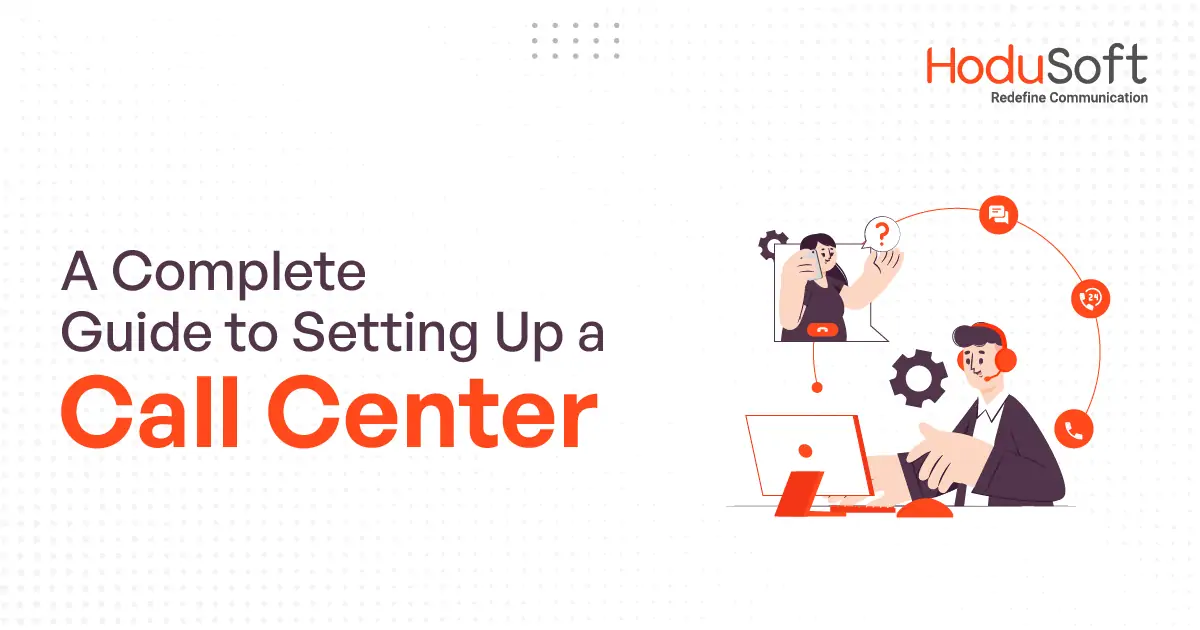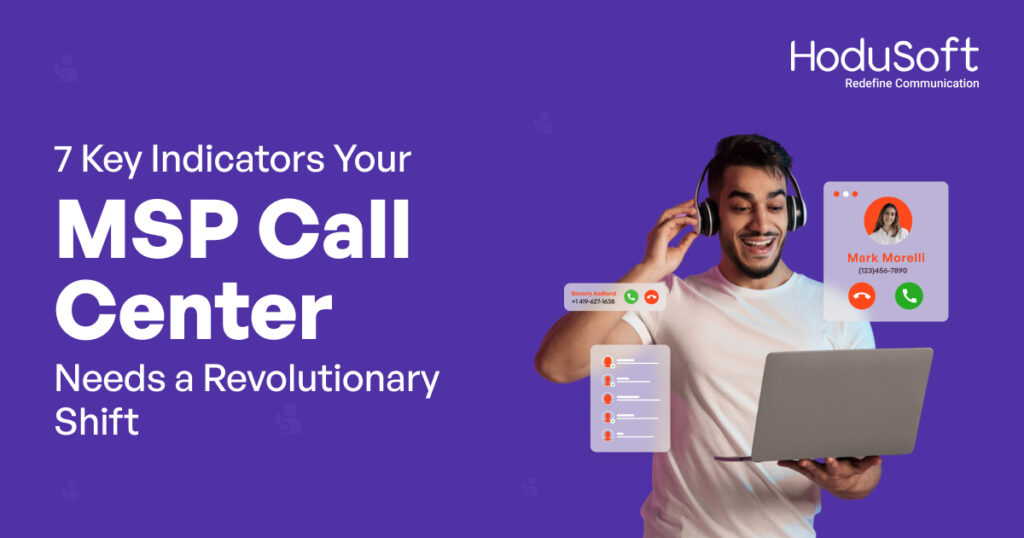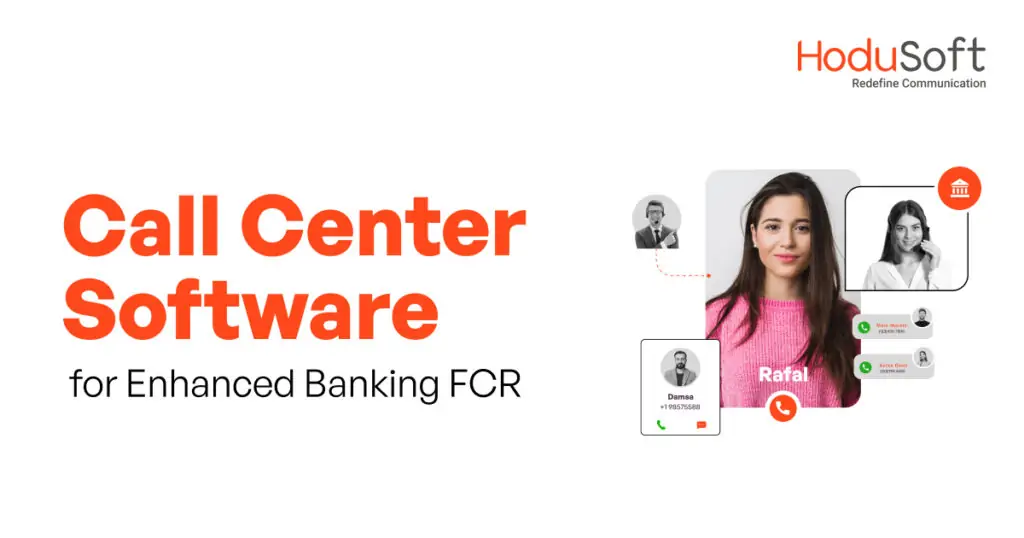A Complete Guide to Setting Up a Call Center
Are you planning to set up a call center? If yes, then you must know everything about call centers starting from all call center systems to how to select the best call center software and customer service agents.
This blog post details everything about call centers starting from different types of call centers, how they work, what call center software is, how it works, and how to set up a call center. Read on and thank us later.
What is a call center?
A call center is an organization (or a team or department within a large organization) that handles both incoming and outgoing calls.
The people who answer incoming calls or make outgoing calls are known as customer service representatives.
Some call centers are subsidiaries of enterprise-level organizations and they handle all customer issues, requests, and queries of their parent company.
Whereas some call centers are independent organizations that provide customer service for various clients.
Types of call centers
Depending on the nature of the calls made and the channels used, there are seven types of call centers.
1. Inbound call centers
As you can guess from the name itself, inbound call centers handle incoming calls, which can range from customers’ requests, queries, issues with products or services, tech support, and more. In inbound call centers, using inbound call center software can streamline incoming calls and enable agents to handle all calls as efficiently as possible.
2. Outbound call centers
As the name suggests, outbound call centers enable companies to make outgoing calls, which include sales calls, feedback surveys, telemarketing campaigns, and market research.
To make outgoing calls, these types of call centers use auto-dialers (predictive dialers or progressive dialers). The right outbound call center software can immensely help businesses to make outgoing calls and generate high-quality leads.
3. Blended call centers
A blended call center merges both inbound call centers and outbound call centers into one. This type of call center handles every type of call ranging from telemarketing sales calls to customer support calls. Companies or organizations that want to provide effective customer service as well as make sales calls can benefit from using blended call centers.
4. Virtual call centers
A virtual call center is a cloud-based call center that enables customer service representatives to work remotely, from various locations across time zones, instead of working from a centralized location. Virtual call centers are extremely flexible and less expensive to run and manage.
5. Automated call centers
As the name suggests, an automated call center automates a large chunk of the calling process by employing computer-based systems. In these call centers, human call center representatives only take some extremely important calls, handle specific responsibilities that the automated call center software can’t complete as well as maintain the systems.
6. Multichannel call centers
Multichannel call centers are those call centers that enable businesses to interact with clients using multiple communication channels. In the present time, many contemporary call centers use multiple channels such as audio calls, video calls, faxes, emails, and other channels to connect with customers.
7. Omnichannel call centers
Omnichannel call centers are one step more advanced than multichannel call centers. While multichannel call centers use multiple communication channels to connect with customers, omnichannel call centers use cloud-based software and nearly all available channels to do the same.
Using omnichannel call center software, customer support representatives can handle customer interactions using a wide range of channels such as audio calls, video calls, text messages, instant messages, live chats, social media, and more.
How does a call center work?
A call center is an organization (or a department within an organization) that’s run by a team of customer service representatives or agents.
As discussed in the types of call centers, the main job of the agents can range from handling incoming calls to making outgoing calls, or a mix of both.
Depending on the type, the call center uses the right type of software that enables it to make the calling process as smooth and efficient as possible.
What is call center software?
Call center software is a cloud-based communication platform that’s designed for call centers to provide high-quality customer service.
It comes with a wide range of cutting-edge features that play a huge role in automating many manual and repetitive calling processes. Some of the most effective features are:
Auto dialer:
As the name suggests, the feature dials phone numbers from a database automatically and connects the call only after a live person picks up the phone. It is equipped to detect and avoid answering machines, busy tones, and no answers.
Automatic Call Distribution:
This feature uses a wide range of distribution strategies to route all incoming calls to available agents. This is extremely common for call centers that deal with a huge volume of inbound calls. The main aim of automatic call distribution is to connect customers with call center agents who have particular skills.
Call Barging and Whispering:
The call barging feature enables managers and supervisors to ‘barge’ between live calls to provide the right information or solution to customers as well as to correct agents’ mistakes. In the call whispering feature, managers and supervisors can guide agents by whispering to them without letting customers know about their presence.
Call Monitoring and Recording:
This feature enables supervisors and managers to monitor all incoming and outgoing calls and listen to conversations in real time. The call recording feature records all calls and enables call center management to train their agents as per their needs.
Multi-level IVR (Interactive Voice Response):
IVR provides customers with a wide range of self-service options and enables them to press specific keys to speak to agents in specific departments. Apart from that, IVR systems provide relevant information and historical data to agents from customers’ past transactions and previous purchases.
Least Cost Routing:
As the name suggests, this feature selects the cheapest path to make outgoing calls and handle incoming calls. By enabling call centers to select call routes based on costs from a wide range of carriers, this feature can lower communication costs.
WebRTC:
This feature provides mobile applications and web browsers with real-time communication, which enables voice, text, and video communication functions between web browsers and devices. By using WebRTC, customer support representatives can answer calls in their browsers without the need for complex integration of IT telephony and add-ons.
How does call center software work?
Being extremely sophisticated and feature-rich, call center software automates many manual and routine calling processes as well as enables customer service representatives to handle both incoming and outgoing calls in an extremely seamless manner.
Call center software comes with real-time analytics and reporting tools, which enable managers and supervisors to keep a close eye on agents’ performance and other KPIs.
By easily integrating with SMS, CRM (customer relationship management), and ERP (enterprise resource planning) systems, it enables agents to know all relevant things about customers and prospects.
Now let’s discuss how to call center software while receiving an incoming call. When callers dial a call center’s number, they get to interact with an IVR system, which provides them with a wide range of language and other options and takes their preferred options.
It also asks them if they want to speak with a customer center representative and connect their call to the most suitable agent.
As the call gets directed to the most suitable agent, the call center software displays the entire caller information in front of the agent after browsing through the database.
If the caller is completely new and their data is not in the system, then the call center software will display the caller’s registered name and number and will keep all the relevant details for future reference.
In the case of outgoing calls, call center software automatically dials customers’ phone numbers using sophisticated features such as auto dialers or predictive dialers, or progressive dialers.
It only connects call center agents after a live customer picks up the phone. If it detects answering machines, busy tones, or no answers, then it moves on to the next number. After a live person answers the call, it displays relevant customer information on the agent’s screen and continues the call forward.
How to set up a call center?
Setting up a call center can be a complex and challenging task, but it can also be rewarding and profitable if done right.
There are many factors to consider, such as the type, size, location, budget, technology, staff, training, and culture of your call center.
Here are some general steps to guide you through the process.
Different entrepreneurs set up call centers for different reasons. No doubt, call centers are a profitable business and the global call center industry is rising at a rapid pace.
A Research and Markets report projected a six percent compound annual growth rate for the global call center market size, from USD 404.3 billion in 2020 to USD 607.6 billion by 2027.
In the U.S. alone, call centers generate annual revenue of nearly USD 21 billion with an average revenue of USD 4 million. Here are some ways to set up call centers:
Assess your goals and know your purpose
Before deciding to start a call center, ask yourself “Why call center?” Is it because it presents immense opportunities to make money or is it because you are genuinely interested in call centers or you want to provide exceptional customer service? Or do you want to generate qualified leads for your (or someone else’s) business?
If only money is the answer, then the call center may not be your cup of tea. You should look for other areas that excite and interest you.
But if you’re passionate about call centers and customer service, then setting up a call center may be a good idea for you.
Choose the right type of call center
By now, you already know the different types of call centers. Your purpose and business objectives will help you decide on the right type of call center.
For instance, if you intend to provide customer service or support, then an inbound call center would be perfect for you. If you want to conduct surveys or intend to generate qualified leads, then an outbound call center would be right for you.
If you want to handle both types of calls, then a blended call center would be useful.
You can also decide on the type of call center based on the channels you would like to use as well as your call center’s remote working policy.
That will help you decide if you want to invest in an omnichannel or multichannel call center as well as virtual call centers.
List out key software features you want in your call center software and set a reasonable budget
After determining the right type of call center, list out the key features you would like in your call center software. If you need an incoming call center, then you must have key features such as automatic call distribution, skill-based routing, multilevel IVR, and more.
If you want an outbound call center, then you must focus on key features such as auto dialer, predictive dialer, and progressive dialer, among others.
After determining the right type of call center and the most important features, set a reasonable budget. It should include everything from the location and size of the call center, the hardware and software, the number of call center agents you want to hire, as well as the wages and salaries. You need to be extremely careful about the budget as it can make or break your call center.
Determine how many agents you need in your call center and hire accordingly
In the next step, you need to determine how many agents you need to handle the workload and call volume. After that, ensure that you hire the right number of skillful and qualified employees.
The team can include professionals such as customer service representatives, sales representatives, technical support specialists, and more. Make sure that your hiring process is thorough, efficient, and quick.
After that, schedule interviews and go through the applications extremely thoroughly. Even though it’s important to focus on experience, skills, and prior achievements, it’s also critical to be flexible as some of the best talents come as a fresher.
After completing the interviewing process, handpick the best candidates as per their performance and potential.
After hiring team members, assign them their roles and responsibilities. Make sure that you have the right number of agents, managers, supervisors, and quality analysts as per your needs. After hiring the right number of employees, train them so that they can systematically handle the calls.
Look for a reliable call center software provider
After setting a reasonable budget, it’s time to invest and acquire the best assets you can get for your call center.
Choose the right hardware and equipment that would support your call center’s operations. Having computer systems and internet connection in place is relatively easy.
You can never go wrong with your favorite computer brand, the best headset manufacturer, a reputable antivirus software maker, and a reliable internet connection provider.
But when it comes to choosing the soul of your call center, which is the call center software, you will have to do proper research and select the right solution provider in the market.
In this phase, the internet can be immensely helpful. Using some high intent and highly focused search terms such as “top call center software 2023,” “cost-effective call center software,” “best call center software for small businesses,” “best call center software,” “top call center software for small enterprise,” “free demo call center software,” “top call center software for small businesses,” among others.
If you’re looking for call center software in a particular country, use location-specific search terms such as “best call center software in the US,” “best call center software in Canada,” “best call center software in the UK,” “best call center software in Australia,” “best call center software in South Africa,” and “best call center software in India.”
Compare software and prices and make a buying decision
After getting the search results, visit the websites and compare software, features, pricing plans, as well as client testimonials.
You can also go to some aggregators’ websites to look at the top 10 or 20 call center software in one place and compare their features, prices, ratings, and reviews, as well as pros and cons.
After shortlisting some software providers, call them and ask more about their products. Ask them if they provide a free demo.
If they do, ask more about the free trial and how many days you can use the software for free. If everything goes well, take the free demo and ask your team members to use it and give their feedback.
Train your agents
The last and most important step, make sure that your agents are well-trained and skillful before they handle live calls. As per data, most call centers spend between six and twelve weeks on training and onboarding new agents.
But some small call centers have a training period of one to two weeks as they don’t have the time to train their agents for more than that. They induct their recruits on live projects and provide them with on-the-job training.
The most important thing your agents need to be trained on is how to use the call center software and how to handle the calls in your call center.
Here’s where the role of sophisticated yet simple call center software can be hugely beneficial. Ensure that your agents are well-trained in proper etiquette and adhere to the call center script.
A word of caution though; a 2018 study revealed that more than three-fourths of customers believe that they get a better experience when a representative doesn’t read from a script.
If you’re using a script, tell your agents not to read it but keep the important points in their minds.
Taking everything into account
If you want to provide exceptional customer service to your customers or help other businesses do just that, setting up a call center can prove to be extremely rewarding.
But when it comes to setting up a call center, having the right strategies in place is critical. You need to hire the right people, select the right call center software and equipment, and train your agents in the best possible way.
At HoduSoft, we have helped many businesses set up and successfully run several types of call centers. Our HoduCC call center software comes with several cutting-edge features that can help you provide the best-in-class customer service.



